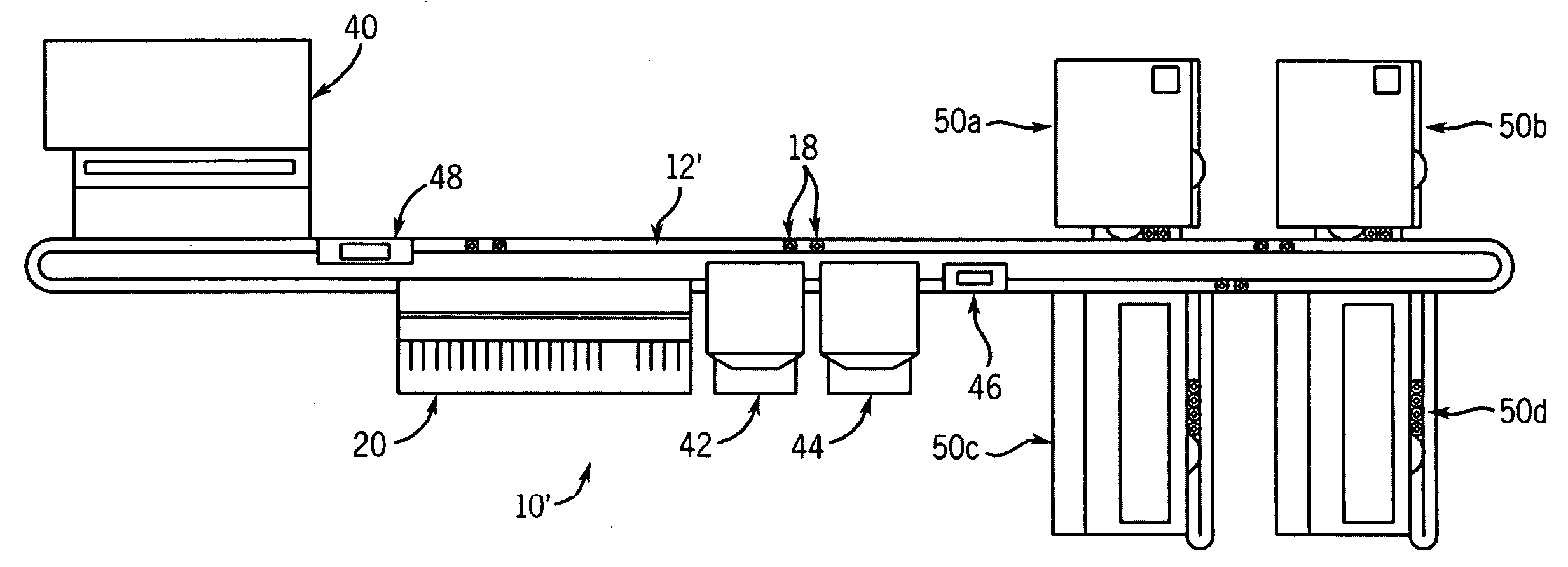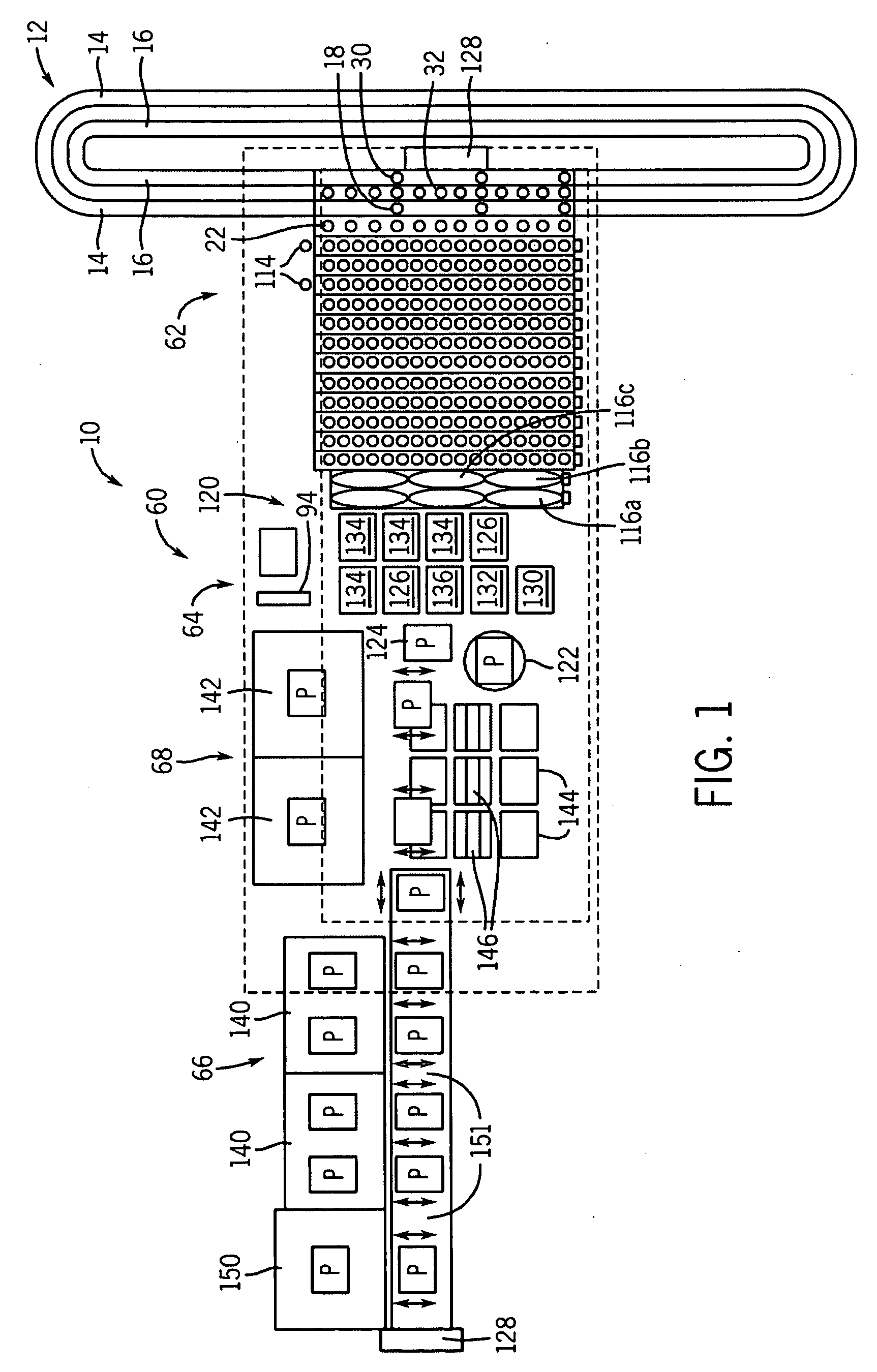Automated analyzer for clinical laboratory
a clinical laboratory and analyzer technology, applied in the field of clinical laboratory automated analyzers, can solve the problems of large volume of liquid waste and solid waste generation, high cost, and the inability of the above-mentioned automated analyzer to be modified to suit the demands of certain users, and achieve the effect of manual loading of reagents
- Summary
- Abstract
- Description
- Claims
- Application Information
AI Technical Summary
Benefits of technology
Problems solved by technology
Method used
Image
Examples
example 1
[0171]This example illustrates how an immunoassay can be performed by means of inverse magnetic particle processing followed by reading results by means of a luminescence reader.
[0172]The magnetic particle processing steps can be carried out by means of inverse magnetic particle processing, with the steps of binding, collecting, washing, mixing, separating, and incubating being carried out in the micro-wells of a micro-well plate. Referring now to FIG. 13, a micro-well plate having eight (8) rows and twelve (12) columns is illustrated. A different assay is carried out in each column. A different process step is carried out in each row. In some rows, the process steps are varied on account of variations in the protocol of the assay. For each assay, the micro-well in the first row is blank. In each micro-well in the second row of the first eleven assays the sample is combined with the magnetic microparticle reagent. In each micro-well in the third row, the fourth row, the sixth row, a...
example 2
[0174]This example demonstrates kitting a micro-well plate for a homogeneous immunoassay. A homogeneous immunoassay is an immunoassay that does not require a separation step. An immunoassay for choline can be a homogeneous immunoassay, i.e., the immunoassay does not require magnetic separation and washing steps. Furthermore, only one micro-well is required for each immunoassay. FIGS. 17A, 17B, and 17C represent micro-well plates to be kitted for immunoassays. FIG. 17A shows the sample and a first reagent in each micro-well of the micro-well plate. FIG. 17B shows the sample, the first reagent, and the addition of the enzyme choline oxidase in each micro-well of a micro-well plate. FIG. 17C shows the sample, the first reagent, the enzyme choline oxidase, and the addition of the acridinium signal generator in each micro-well of the micro-well plate. After the additions of the reagents and a suitable period of incubation, the micro-well plate is inserted into a luminescence reader, and ...
example 3
[0175]This example illustrates a clinical chemistry assay using micro-well plates. FIGS. 19A, 19B, 19C, 19D, 19E, and 19F illustrate micro-well plates to be kitted for clinical chemistry assays. Referring now to FIGS. 19A, 19B, 19C, 19D, 19E, and 19F, the micro-well plate has eight (8) rows and twelve (12) columns. Columns 1-6 from the left involve assays for glucose (Glu), cholesterol (Chol), alanine transaminase or alanine aminotransferase (ALT), troponin (TP), Urea (Urea), and triglycerides (Trig), respectively. Columns 7-12 from the left involve the assays Glu, Chol, ALT, TP, Urea, and Trig, respectively. Rows 1-8 and columns 1-6 involve assays for eight (8) samples from different sources, i.e., sources John Doe, Jane Doe, Tom Doe, Mary Doe, Jim Doe, Beth Doe, Mike Doe, and Sue Doe. Rows 1-8 and columns 7-12 involve assays for another eight (8) samples from eight different sources, i.e., sources Carl Doe, Cindy Doe, Hank Doe, Julie Doe, Bob Doe, Pam Doe, Paul Doe, and Kim Doe. T...
PUM
| Property | Measurement | Unit |
|---|---|---|
| Frequency | aaaaa | aaaaa |
Abstract
Description
Claims
Application Information
 Login to View More
Login to View More - R&D
- Intellectual Property
- Life Sciences
- Materials
- Tech Scout
- Unparalleled Data Quality
- Higher Quality Content
- 60% Fewer Hallucinations
Browse by: Latest US Patents, China's latest patents, Technical Efficacy Thesaurus, Application Domain, Technology Topic, Popular Technical Reports.
© 2025 PatSnap. All rights reserved.Legal|Privacy policy|Modern Slavery Act Transparency Statement|Sitemap|About US| Contact US: help@patsnap.com



